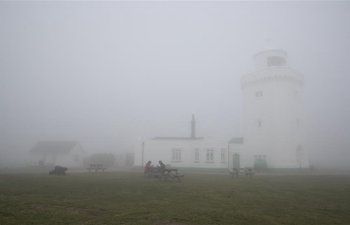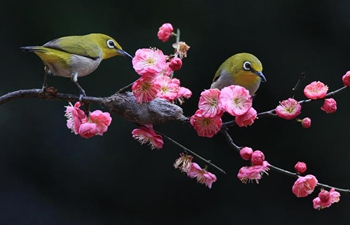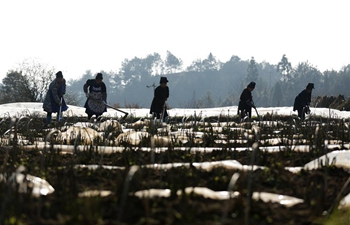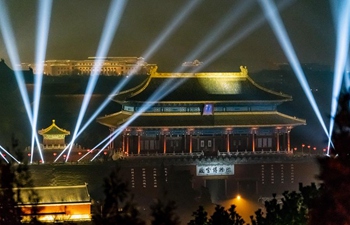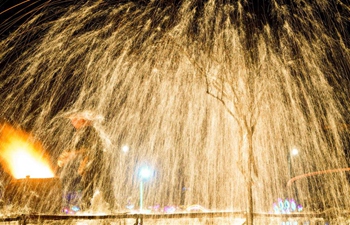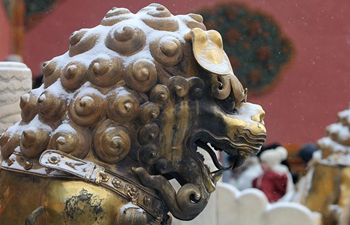
Photo taken on Feb. 19, 2019 shows the night scenery at Wumen Gate of the Palace Museum, or the Forbidden City, in Beijing, capital of China. The Palace Museum extended its opening hours to the evening for the first time on Feb. 19 and Feb. 20 in celebration for this year's Lantern Festival. (Xinhua/Chen Jianli)
BEIJING, Feb. 23 (Xinhua) -- A national sensation since the Chinese Lunar New Year celebration earlier this month has affirmed the Forbidden City's status as one of the public's favorite landmarks and is an indicator of China's consumption upgrade.
A rare New Year exhibition and a Lantern Festival light show in the former royal palace in central Beijing have created a social media frenzy over the surprising popularity of the limited tickets in the otherwise freezing off-season.
All tickets to the Forbidden City, which allows 80,000 visitors per day, during the week-long Spring Festival holiday were sold out before the holiday season began.
The online ticket booking system suffered from temporary crashes as people rushed to grab the 3,000 free tickets for each of the Lantern Festival night tours on Tuesday and Wednesday.
It was the first time the Forbidden City, now also known as the Palace Museum, was open to the public for free at night in the museum's 94-year history.
Shan Jixiang, the curator of the Palace Museum, said the museum is considering similar cultural activities during other traditional Chinese festivals, such as the Mid-Autumn Festival and the Dragon Boat Festival.
SOCIAL MEDIA LANDMARK
Against the backdrop of the Forbidden City's roughly 600-year-old walls, one after another of ancient China's most renowned paintings unrolled before a rapt audience as a part of the Lantern Festival light show.
The Palace Museum was packed with visitors for the two-day event, with even more people watching the live broadcast on Sina Weibo, a popular social media platform in China.
The museum's journey toward a social media landmark began in 2013 when it rebranded its online store to market creative cultural products with a particularly down-to-earth approach.
Popular items include royal beads-shaped headphones, smartphone cases bearing royal calligraphy and the latest lip-gloss that made customers "feel regal."
Another factor that adds to the museum's hype is the 2016 documentary series "Masters in the Forbidden City." The three-part series about cultural relic restorers at the museum got more than 4.3 million views on the streaming site Bilibili.
The documentary has inspired around 40,000 young people to apply for the job this year, according to Shan.
TRADITIONS REVIVED
Analysts believe the museum's going viral proved a successful traditional culture-oriented development model.
"The knack is to take the cream of Chinese traditional culture and express it in a younger generation-friendly tone," said Chen Shaofeng, vice dean of the Institute for Cultural Industries at Peking University.
Since 2016, the museum has cooperated with several internet giants, such as Alibaba, Tencent and NetEase Games, in areas of ticketing, creative cultural products, publications and games.
"To be creative means that we should closely study and cater to people's needs," said Shan.
According to data from the museum, 40 percent of the customers for its creative cultural products are under 30 years old.
To further endear itself to the masses, the museum launched an app, The Palace Museum, for users to accrue piecemeal information about its antiques on a daily basis.
TOKEN OF CONSUMPTION UPGRADE
"The Palace Museum phenomena showcased China's consumption upgrade," said Wei Pengju, a culture and communications professor at Central University of Finance and Economics.
"Culture-related expenditures are on the rise and becoming more diversified and so is involvement in hands-on cultural experiences," he noted.
The museum has developed more than 10,000 kinds of cultural and creative products, raking in 1.5 billion yuan (223 million U.S. dollars) in sales revenue in 2017, the museum's figures show.
The museum's success is shored up by the prospect of China's cultural and related industries, whose added value totaled about 3.5 trillion yuan in 2017, accounting for 4.2 percent of the GDP.
Shan said that revenue from creative cultural products has funded more than 60,000 non-profit cultural and educational activities last year in China and countries like Malta, Singapore, Thailand and Australia.
"Our mission is more about increasing the influence of the Palace Museum and promoting traditional Chinese culture," he said.






